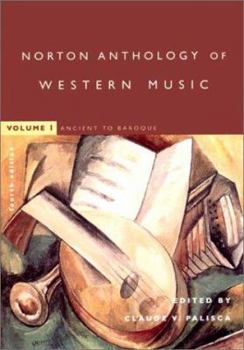Norton Anthology of Western Music: Ancient to Baroque
Select Format
Select Condition 
Book Overview
This comprehensive collection of 150 scores illustrates every significant trend and genre of Western classical music from antiquity to modern times. The Fourth Edition contains 20 pieces new to the collection and an increased number of twentieth-century works (American composers newly represented include Amy Cheney Beach, John Adams, and Ellen Taaffe Zwilich). Each numbered selection is either a complete work in itself or an entire movement from a...
Format:Paperback
Language:English
ISBN:0393976904
ISBN13:9780393976908
Release Date:January 2001
Publisher:W. W. Norton & Company
Length:628 Pages
Weight:2.05 lbs.
Dimensions:0.8" x 7.0" x 10.0"
Customer Reviews
5 ratings
The 6th edition still sets the standard !
Published by Thriftbooks.com User , 20 years ago
I remember the First edition of Grout's "A History of Western Music"--it was the main text in use when I was a first year undergraduate student. In fact it was one of the standard texts in use at a large number of colleges. The good news is that I was pleased to see the excellent changes. I didn't have to look far to find my first (1 st) edition Grout ( I've used it still until I purchased this new 6th edition several weeks ago)--there are 101 more pages of text. In reality there is much more to look at as the 1st edition book was only 6 x 9 inches. The new 6th Edition is larger: 7 1/4 by 10 1/2 inches. In addition, there is a highly attractive layout; the best feature? A wonderful highlighted-in-blue area (appearing every 40 pages or so) in which the composers themselves speak about a wonderful range of topics such as Francois Couperin 'On the Union of the Italian and French Styles' or, the great J.S. Bach's description of one the church service's he organized (known as an 'Order of Service') taken from a collection of his memoirs. Lastly, I enjoyed seeing the addition of an overall "Time-Line of Events" which prefaces each unit. This includes not only items from music, but any historical event which remotely affected change in music or musical thought. My singluar critical note is perhaps something which the authors had little time to devote to. The 6th edition ends with composers who, in this reviewer's opinion, were certainly not 'mainstream'--like John Cage (1912-1992) (who's infamous "4'33" is actually a period of four minutes and thirythree seconds in which the 'performer' remains totally silent). Cage was popular in the late 70s more for his extremism than anything else. The last paragraph of the book does state, in effect, that composers are being more sensitive to their audiences. (No doubt! Their INsensitivity nearly killed classical music in the 70s) As with any textbook, deadlines must limit speculation--there will undoubtedly be a 7th edition to address more changes in our musical world. Lastly, the reader should take note that the current author of this work, Claude V. Palisca, is also the author of the "Norton Anthology of Music" which can be used in conjunction with this text. Also, the publisher, W.W.Norton and Co., has a website for readers (which is also mentioned in the text: http://www.wwnorton.com/grout.). The website is still active (I just visited it) and has a wealth of information and listening resources---too bad we didn't have this back in 1967 !
A thorough survey of western music from written sources.
Published by Thriftbooks.com User , 25 years ago
Editors Palisca and Grout present a thorough survey of western music from written sources, with a welcome emphasis on lesser-known works. They include neumes and other ancient methods of notation. Entirely scholarly and accompanied by beautifully executed recordings of each piece, this book is a must for every student of musicology, and a boon to anyone interested in ancient music.
This is the finest text on the history of western music.
Published by Thriftbooks.com User , 25 years ago
This book is Donald J. Grout's masterpiece. Scholarly, detailed, and carefully considered, it includes analyses of pieces from every period in the history of western music. Grout interweaves the development of harmony, rhythm, and usage with the evolution of various instruments and vocal trends, and presents all in the context of social and political history.
This is a collection of scores to the CD selections
Published by Thriftbooks.com User , 25 years ago
Both volumes of the (paperback) Anthology (N.B.: 3d ed. goes with 5th ed. of the "History" text) are primarily fully reproduced (though reduced in size) scores to the music reproduced audiophonically on the CD's in Volumes 1 and 2 of "Recorded Anthology." The Anthology, according to its 3d ed. preface, now contains almost no text of its own. The "History" text (clothbound and yes, definitive) contains minimal examples in musical notation and refers to these two volumes frequently. Despite the above review being included with this volume, be advised that the study guide by J. Peter Burkholder is to the "History" text, not primarily to the Anthologies, which also supplement the History (along with the CD's).
A definitive history of Western art music
Published by Thriftbooks.com User , 26 years ago
"A History of Western Music" is a standard reference text for the academic study of "classical" art music from antiquity to the present (i.e. 1960). As an example of this book's scholarly authority, the 5th edition is commonly the sole information source for many Master's of Music history qualifying exams. Author and Cornell professor emeritus Donald Grout writes with a straightforward style and elucidates his prose with many colorful pictures and musical examples. All those looking for a thorough, single volume survey of Western art music should make this book the first addition to their library.





